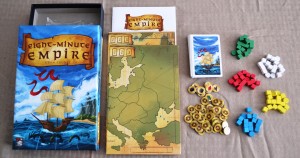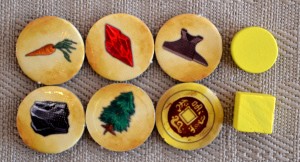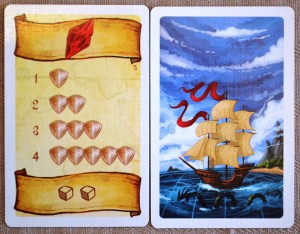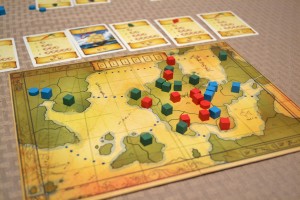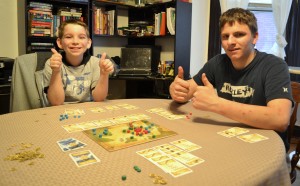I’m a big fan of games like “Civilization” and “Risk”, but they often require the user to invest over the long haul…time, effort, a kidney, that sort of thing. “Eight-Minute Empire” solves that problem by simplifying the overall theme to the point where games can be played in under a half-hour’s time. That’s pretty impressive, if I dare say. It’s an area control game at heart that tasks players with conquering lands and owning goods in an effort to score the most victory points. Before we get started taking a look at this game in further detail, I’d like to thank Ryan Laukat from Red Raven Games for providing me with a free review copy.
Components
Wooden Cubes & Discs – There are five sets of cubes and discs, each with their own color. They represent a player’s armies and cities, respectively.
Cards – Each card lists an action and a resource. Players will be collecting these throughout the game to perform actions (for immediate effect) and que up resources for endgame scoring.
Coin Tokens – Players will be using these as a form of currency to purchase cards throughout the game.
Goods Tokens – Players will be trading wild cards that they’ve purchased for these at the end of the game.
Game Board – The game board is double-sided. Each side has regions, which form continents (similar to “Risk”). Along the top of the board are six numbers, each representing the costs associated with purchasing a card.
Europe Board (Expansion) – This extra board came with my review copy. It was given to Kickstarter backers who pledged over a certain amount. It is two-sided as well, giving us a total of four maps to play around with.
Setup & Gameplay
First, players will need to decide which side of the board on which to play. The cards are shuffled and placed face down to form a draw deck, though any cards with a “5” on them will need removed first if playing with two, three, or four players. Six cards are drawn from the deck and placed face-up (horizontally) above the playing board. Each player selects a colored set of cubes and disks, placing three cubes on the “Start” region. In the event of a two player game, players will take turns placing ten cubes of a third color around the board. Each player takes a set number of coin tokens, the number of which depends on how many people are playing the game.
The starting player is determined via a bid. Each player takes an undisclosed number of coin tokens into their hand and reveals them all at once. The player with the highest bid goes first, but must give up those coins to the bank. The other players get to keep their coins.
On a player’s turn, they will:
1) Take a card from the six available cards on the table, paying the appropriate cost with coin tokens. To determine a card’s cost, player’s will need to look at the six numbers along the top of the board. The six numbers represent the costs for the six cards laid out. If the numbers are 0,1,1,2,2,3 for example, the fifth card would always cost two coin tokens.
2) Follow the action listed on the card (optional). Actions can range from placing new armies, moving existing armies, building a city, and destroying armies. The action is listed along the bottom of the card. The resource type and value table displayed above it are actively ignored until end-game scoring.
3) Move the cards in the six card row to the left to fill any empty slots. A new card is drawn from the deck and placed in the right-most (most expensive) slot.
Players continue taking turns (play proceeding clockwise) until each player owns a set number of cards. After that, players add up how many victory points they’ve earned. Victory points are earned by owning regions, continents, and goods. Players earn one point for every region they control and one point for every continent they control. In regards to scoring goods, players will need to pair up their resources into sets and consult the chart on the cards. Wild cards are traded in for goods tokens to be added to those sets. Generally, the more of a particular good you have, the more victory points you could potentially earn. The person with the most victory points wins the game!
The above is simply an overview and doesn’t cover all of the rules found in the manual, but should give you an idea as to how the game is played. For more information, please consult the links at the end of this article. There’s also a print and play manual at the below link, but it differs slightly from my copy.
http://www.redravengames.com/wp-content/uploads/2012/10/eightminuteempire_pnp_rules04.pdf
The Review
Firstly, the components were of fairly good quality. The tokens had a thicker feel about them compared to some of the other games in my collection that feature cardboard pieces. The board is of thicker quality as well, which I appreciate. The cube and disc sets each came in their own plastic baggie, making clean-up easy and organized. The rulebook is only four pages (two pages front and back), but does a fairly good job in explaining the rules. All in all, I was happy with both the size and quality of the game and its components.
In terms of strategic gameplay, there’s a few different things going on at the same time. Not only will players be aiming to collect resources of the same type, but they’ll need to be managing their armies in ways that ensure adequate board coverage. Since actions and resources are located on the same card, players will often be trying to decide if they should be focusing their efforts on the short-term (very helpful actions) or long-term (resource collection). There’s also card costs to consider, since players are limited to the money that they started with.
There is a luck factor at work, considering that the cards are shuffled and come up randomly as the game progresses. However, seeing that players can pick and choose from six different cards which alternate positions as they remain in play, I’m inclined to consider this more of a strategic game than one based off of luck. Cards that were expensive and not as accessible will be less so the longer they remain in play. This ensures that unpopular cards eventually become a subject for consideration, much like unpopular races do in “Small World”.
The manual includes a number of variants to help mix up gameplay. For example, players can opt for a longer play experience by playing three games, adding the victory points from each for a grand total to determine the winner. In another variant, goods tokens are placed on regions with a triangle on them. Players who control those regions at the end of the game count them as extra goods when scoring resources. The game is flexible enough to come up with your own variants, which I appreciate. I’ve been toying with the idea of gifting all players one or two coin tokens mid-game (when players reach half of their card goal) to help them purchase more expensive cards as the need arises. I’ve also considered extending gameplay an extra round or two, just to give players more time to move their armies around the board. I’m very pleased that the game is able to accomodate creative minds.
Our play sessions were positive overall. Vinnie (12) had the most trouble, though it wasn’t due to understanding how the game was played. The game is over relatively quickly, meaning that your time-management skills will be tested a bit. In this area, Vinnie sometimes made moves that weren’t the most lucrative. I had no problems with putting on my coach hat however and showing him how best to make use of the limited time in which he had to play. He ended up with the least amount of armies but had the most territories. Anthony (17) was all about controlling the starting continent, giving him a lot of points. Out of the three of us, I was the one who opted for cards that complimented my resource stock. While my territory coverage was average at best, I managed to tie Vinnie for first place due to some carefully calculated card purchases.
In the end, I was very impressed with “Eight-Minute Empire”. It’s quick and easy to play, but will force you to make some pretty tough decisions. Despite the game’s name, our play times averaged at roughly twenty minutes per game. This was due to the learning curve and the distractions that come with a chaotic household such as mine. I have no doubt however that experienced players could zip right through a game in under ten minutes if they tried. There are a lot of small pieces, so I’d suggest keeping the game away from toddlers and pets, if at all possible. This game is easily recommendable for both family game night and as a filler in between longer game sessions.
An update on the game’s Kickstarter page shows that copies were mailed at the end of April 2013, so backers should have their copies soon, if not already. As of 5/7/13, the official site mentions that the game is “coming soon”, so keep an eye out for this little gem.
Editor’s Note (5/8/13): Ryan got in touch with me and indicated that the game would be available online next week (or so). He also mentioned looking into making them available in stores.
Final Verdict: 9/10
—
You can learn more about “Eight-Minute Empire” by visiting the following websites:
http://www.redravengames.com/eight-minute-empire/
http://boardgamegeek.com/boardgame/131366/eight-minute-empire
http://www.kickstarter.com/projects/953146955/eight-minute-empire
—

